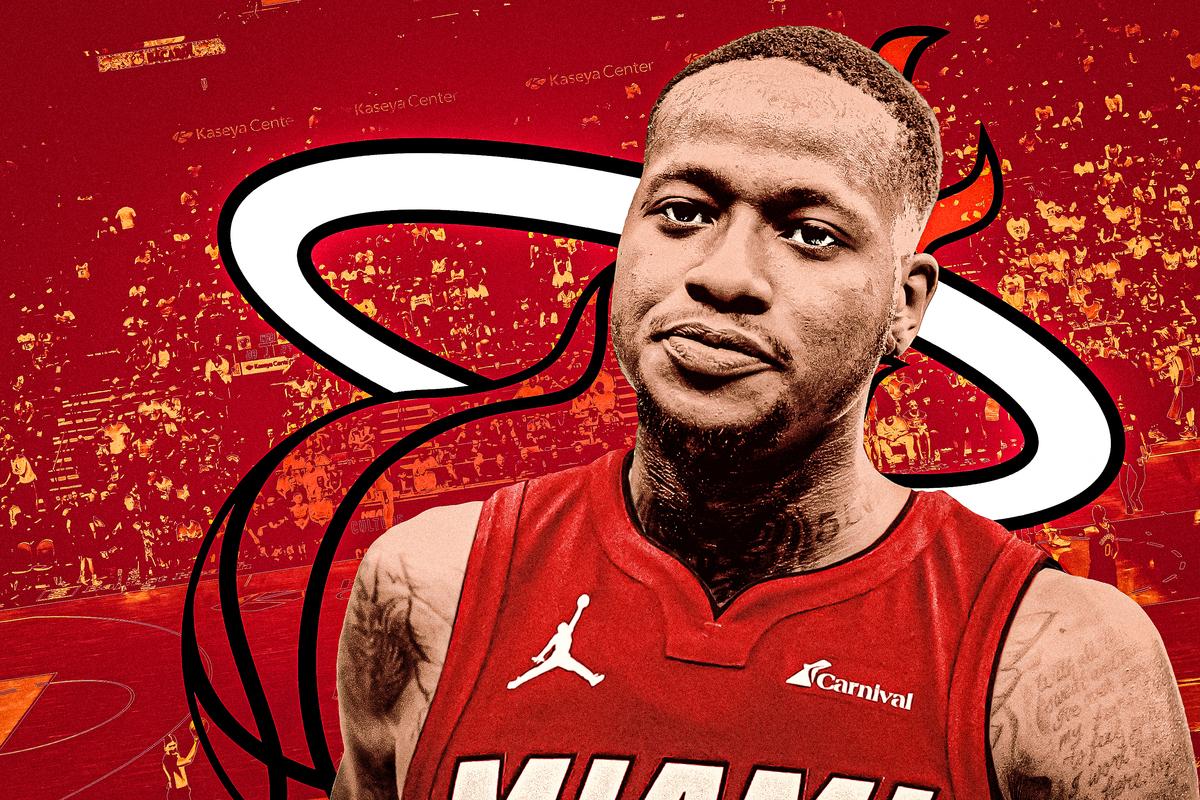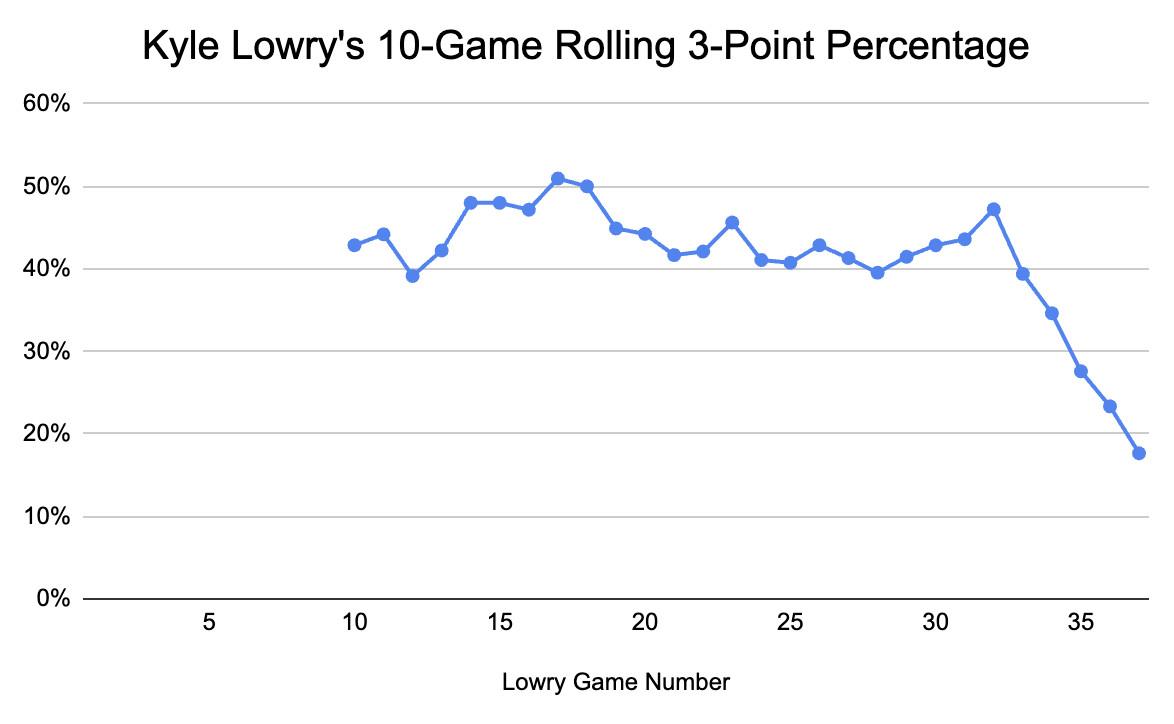
The most prominent individual story lines about the Miami Heat this season are uniformly positive. Jaime Jaquez Jr. is a lock for the All-Rookie first team, even though he went no. 18 in the draft. Duncan Robinson is thriving once more, and not just shooting 3s now. Jimmy Butler, Bam Adebayo, and Tyler Herro are all averaging at least 20 points per game—the only such trio in the NBA to meet that criterion (minimum 24 games played).
Yet those individual trees make up a gloomier forest. The Heat are just 24-19 and tied for sixth in the East, and they rank 20th in offensive rating—only one spot ahead of the Los Angeles Lakers, whose offensive struggles are well documented. This issue isn’t merely a residue of injuries, either: The Heat offense is below average even when their best players are on the court, and they’re just 15-13 in games that Butler has played.
Miami Heat Offense This Season
This isn’t a new problem for Miami, which last had a top-10 offense in 2019-20, when it reached the Finals in the bubble. (The team was an even worse 25th on offense last season, before coming to life in the playoffs.) Internal development and undrafted finds can do only so much. So the Heat sought an external upgrade and agreed to a trade for Hornets guard Terry Rozier. In return, Charlotte will receive Kyle Lowry and a lottery-protected 2027 first-round pick.
Rozier has never been an All-Star, and casual NBA viewers probably haven’t thought about him much as he’s toiled away in Charlotte for the past half decade. But he should fit in as an excellent complementary creator and scorer given the Heat’s long-standing needs.
On the Heat, Rozier won’t run a 27 percent usage rate, as he has with the Hornets. His scoring output will presumably drop from its current perch, a career-high 23.2 points per game, and his career-high 6.6 assists per game mark will likely decline as well, with the ball more often in his Heat teammates’ hands.
But those counting stats point to Rozier’s growth, as the formerly inconsistent spark plug has transformed into a reliable, multidimensional starting guard. Now 29 years old, he’s not just racking up numbers because he gets lots of opportunities on a bad team: Even with career-high usage, Rozier has been more efficient than Herro—who, for all his offensive talents, has had a below-average true shooting percentage in every season of his career.
Advanced stats capture Rozier’s production this season even more favorably. Estimated plus-minus pegs Rozier’s offense in the same range as that of guards like Desmond Bane and Anthony Edwards. Box plus-minus places Rozier’s offense all the way up at 25th among qualified players.
Beyond just his scoring, Rozier adds at the margins. He’s getting to the line more than ever. He rarely turns the ball over, despite his high usage—a trait he shares with Butler. And with Miami, which lacks high-volume shooters aside from Robinson and Herro, Rozier won’t be afraid to let fly from deep; he’s averaging 7.7 3-point attempts per game this season and converting them at a respectable 36 percent rate.
For Miami, his addition at Lowry’s expense represents an offense-for-defense trade-off, a lite version of Milwaukee’s Damian Lillard–for–Jrue Holiday exchange in the offseason. All the advanced stats that relish Rozier’s offense think he’s a notable negative on the other end, whereas Lowry remains a strong defender even at 37 years old.
But Lowry no longer looks like a capable starter for a team with championship aspirations. With his hefty contract set to expire after this season, he seemed like an obvious trade candidate if Miami wanted to improve its roster for a run at the 2023-24 title.
Lowry started this season on fire from distance, albeit at middling volume, but his performance has cratered recently. In nine games in January, he’s averaged only 4.4 points per game on 29 percent shooting (16 percent on 3-pointers). That’s a small sample, but also a continuation of Lowry’s late-career progression. He came off the bench in his past two games, as Erik Spoelstra started bigger lineups—with Adebayo, Butler, Caleb Martin, and Nikola Jovic next to just one guard, Herro—instead.

All of the context surrounding Miami’s mediocrity and Lowry’s decline makes this trade a no-doubter for Miami, at least in the short term. The zoomed-out, bigger-picture question is what the team’s acquisition of Rozier, who’s signed for two years and $52 million beyond this season, means for its greater star-hunting priorities. The Heat now have four players earning more than $20 million per year after 2023-24, and they parted with a first-round pick they could use in a potential blockbuster down the line.
Yet despite the Heat’s reputation for star imports, the team hasn’t pulled one off for a while. Depending on how one feels about post-prime Lowry or P.J. Tucker or post-injury Victor Oladipo, Rozier is the best player Miami has added since it completed a sign-and-trade for Butler five years ago. And with potential targets like Giannis Antetokounmpo and Joel Embiid now looking unlikely to demand a trade anytime soon, the Heat evidently decided they couldn’t let a hypothetical future outweigh the dire needs next to a solid core already in place.
Does Rozier lift the Heat to the top tiers of title contention? At least by normal metrics, that suggestion seems specious. Miami scarcely has a positive point differential on the season, and its defense has fallen to 12th in the league, per Cleaning the Glass, the franchise’s worst mark since 2014-15 (the first post-LeBron year). Like the Lakers, the Heat are struggling this season not just because of a sputtering offense, but because their defensive foundation is showing new cracks as well. Rozier might widen those cracks even as he helps the offense get unstuck.
Moreover, the top five teams in the Eastern Conference standings might already be set: The Celtics, Bucks, and 76ers make up a clear top three, while the Cavaliers and Knicks in fourth and fifth are both on fire of late and have much better underlying numbers. If Miami can’t rise any higher than sixth, it might have to run a 76ers-Bucks-Celtics gauntlet to return to the Finals.
Yet if any team can pull off that feat, it’s obviously the Heat, who have won more playoff series over the past four seasons than any other team in the NBA. Most of those victories came as the underdog and against those specific Eastern heavyweights. “Normal metrics” might not apply to Miami, at least not without a special variable for Heat culture built in.
So perhaps a better question is: Would any of the best teams in the East want to face a Miami roster that just added another 20-points-per-game scorer in a playoff series? Almost certainly not.


